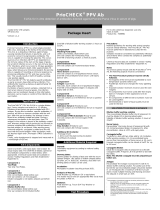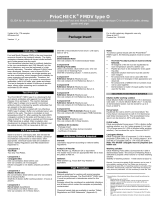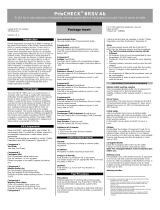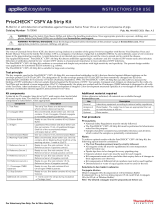Page is loading ...

PrioCHECK
®
SVDV Ab
ELISA for in vitro detection of antibodies against Swine Vesicular Disease Virus in plasma and serum of pigs
5 plate kit for 440 samples
©Prionics AG
Version 1.1_e
For in-vitro veterinary diagnostic use only
Store at 5±3°C
Product No.: 7610205
Introduction
Swine Vesicular Disease (SVD) is a highly contagious
viral disease of pigs. Swine Vesicular Disease Virus
(SVDV) is a member of the enterovirus genus in the
family Picornaviridae. Although the disease is often
mild in nature, it is an O.I.E. list A disease since it is
clinically indistinguishable from Foot and Mouth Dis-
ease. For this reason outbreaks of SVD must be
assumed to be Foot and Mouth Disease until labora-
tory diagnosis proves otherwise.
The PrioCHECK
®
SVDV Ab meets the requirements
for use in SVDV-screening programs. Based on a field
study in the Netherlands a specificity of at least 99%
and a sensitivity of 95% were found. In addition, the
PrioCHECK
®
SVDV Ab is a convenient and simple
test, which can be performed within 3 hours.
1
It is
particularly suitable for use with automated ELISA
systems, e.g. robots.
All positive tested samples should be confirmed in the
virus neutralization test.
Test Principle
The PrioCHECK
®
SVDV Ab is a competitive double
antibody sandwich test.
Test Plates are coated with the mAb SVDV UK-72
followed by incubation with SVDV-antigen. Conse-
quently, Test Plates of the kit contain SVDV-antigen
captured by the coated mAb. The test is performed by
dispensing the test sample and subsequently Conju-
gate (mAb SVDV UK-72/HRPO) is added to the wells
of a Test Plate. After incubation, the plate is washed
and the Chromogen (TMB) Substrate is dispensed.
After incubation at room temperature (22±3°C) the
color development is stopped. Color development
measured optically at a wavelength of 450 nm shows
the presence of antibodies directed against Swine
Vesicular Disease Virus.
The PrioCHECK
®
SVDV Ab is a single dilution test.
Serum and/or plasma samples are tested in a 1:5
dilution.
Kit Components
Store kit at 5±3°C until expiry date. See kit label for
expiry date.
The shelf life of diluted, opened or reconstituted
components is noted below, where appropriate.
Chemical hazard data are available in section “Safety
Regulations and R&S Statements” (Appendix II).
Component 1
Test Plate
Five Test Plates.
Component 2
Conjugate (30x)
(30x concentrated, dilute before use)
One vial contains 1.5 ml Conjugate.
Diluted conjugate is not stable, prepare just before
use.
Component 3
Conjugate Additive (30x) (lyophilized)
(30x concentrated, reconstitute before use)
One vial contains 1.2 ml lyophilized Conjugate Addi-
tive.
Shelf life of reconstituted Conjugate Additive: until
expiry date stored at -20°C.
Component 4
Washing Fluid (200x)
(200x concentrated, dilute before use)
One vial contains 60 ml Washing Fluid.
Shelf life of washing solution: 1 week at 22±3°C.
Component 5
Dilution Buffer (Ready-to-use)
One vial contains 60 ml Dilution Buffer.
Component 6
Demineralized Water
Two vials, each contains 10 ml Demineralized Water.
Component 7
Blocking Reagent (lyophilized)
Five vials, each contains 2.0 ml lyophilized Blocking
Reagent.
Shelf life of reconstituted Blocking Reagent: until
expiry date stored at -20°C.
Component 8
Reference Serum 1 (Ready-to-use)
One vial contains 0.5 ml Reference Serum 1 (strong
positive control).
Component 9
Reference Serum 2 (Ready-to-use)
One vial contains 0.5 ml Reference Serum 2 (weak
positive control).
Component 10
Reference Serum 3 (Ready-to-use)
One vial contains 0.5 ml Reference Serum 3 (negative
control).
Component 11
Chromogen (TMB) Substrate (Ready-to-use)
One vial contains 60 ml Chromogen (TMB) Substrate.
Component 12
Stop Solution (Ready-to-use)
One vial contains 60 ml Stop Solution.
Additional Kit Contents:
- Package Insert
- 5 plate sealers
- Certificate of Analysis
Additional Material Required
General:
Laboratory equipment according to national safety
regulations.
Analysis of Results:
Plate Reader e.g. Multiscan EX or equivalent.
The reader has to have an appropriate filter set to read
the plates at 450 nm.
Optional:
Plate washer e.g. Tecan EIA Tray Washer or
equivalent.
Test Procedure
Precautions
National guidelines for working with animal samples
must be strictly followed. The PrioCHECK
®
SVDV Ab
must be performed in laboratories suited for this
purpose.
Samples should be considered as potentially infectious
and all items which contact the samples as potentially
contaminated.
Chemical hazard data are available in section “Safety
Regulations and R&S Statements” (Appendix II).
Notes
To achieve optimal results with the PrioCHECK
®
SVDV Ab, the following aspects must be considered:
The Test Procedure protocol must be strictly
followed.
All reagents of the kit must be equilibrated to
room temperature (22±3°C) before use.
Pipette tips have to be changed for every pipet-
ting step.
Separate solution reservoirs must be used for
each reagent.
Kit components must not be used after their
expiry date or if changes in their appearance are
observed.
Kit components of different kit lot numbers must
not be used together.
Demineralized or water of equal quality must be
used for the test.
SOLUTIONS TO BE MADE IN ADVANCE
Conjugate Additive
Reconstitute
1
the lyophilized Conjugate Additive
(Component 3) with 1.2 ml Demineralized Water
(Component 6). For partial use of the test kit, the
reconstituted conjugate additive should be aliquoted
into 120 µl (for a maximum of 5 tests) and stored at -
20°C until expiry date.
Blocking Reagent
Reconstitute
1
the lyophilized Blocking Reagent (Com-
ponent 7) with 2 ml Demineralized Water (Component
6). Can be stored at -20°C until expiry date.
Conjugate dilution
Add 200 µl reconstituted conjugate additive, 1.8 ml
reconstituted blocking reagent and 200 µl Conjugate
(30x) (Component 2) to 3.8 ml Dilution Buffer (Compo-
nent 5) and mix carefully.
Note: The diluted conjugate must be prepared just
before use.
Washing solution
The Washing Fluid (Component 4) must be diluted
1/200 in demineralized water. A total volume of 12
liters of washing solution can be prepared from one
vial Washing Fluid. Commercially available ELISA
washers can be used.
Stability of washing solution: 1 week stored at 22±3°C.
INCUBATION OF SAMPLES, REFERENCE SERA
AND CONJUGATE
1.1 Dispense 50 µl of Dilution Buffer (Componente
1 Reconstitution of the lyophilized reagents should be performed as follows:
- Equilibrate the vials to 22±3°C.
- With the vial in an upright position, tap the vial gently against the
worktop to ensure that the content is on the bottom of the vial.
- Open the vial.
- Add the required amount of Demineralized Water.
- Replace the stopper on the vial and gently rotate the vial so that any
remaining dry material is dissolved.
- Allow the lyophilized material to stand for 15 minutes at 22±3°C.
- Occasionally gently invert the vial (formation of foam should be
avoided).
Package Insert

PrioCHECK
®
SVDV Ab
5) to wells G1 and H1 of the Test Plate (Com-
ponent 1).
1.2 Dispense 40 µl of Dilution Buffer to all remain-
ing wells of the Test Plate.
1.3 Dispense 10 µl of Reference Serum 1 (Compo-
nent 8) to wells A1 and B1 of the Test Plate
(=OD
450
blank).
1.4 Dispense 10 µl of Reference Serum 2 (Compo-
nent 9) to wells C1 and D1 of the Test Plate.
1.5 Dispense 10 µl of Reference Serum 3 (Compo-
nent 10) to wells E1 and F1 of the Test Plate.
1.6 Dispense 10 µl of the test samples in each of
the remaining wells.
1.7 Add 50 µl of the diluted conjugate to all wells of
the Test Plate.
1.8 Mix the contents of the plate manually or with a
plate shaker.
1.9 Cover the plate with a plate sealer.
1.10 Incubate for 120±5 minutes at 22±3°C.
INCUBATION WITH CHROMOGEN (TMB)
SUBSTRATE
2.1 Empty the Test Plate and wash 6 times with
200 to 300 µl washing solution per well. Tap the
plate firmly after the last washing (soaking the
wells with washing solution is not needed).
2.2 Dispense 100 µl of the Chromogen (TMB)
Substrate (Component 11) to all wells.
2.3 Incubate for 20 minutes at 22±3°C.
2.4 Add 100 µl of the Stop Solution (Component
12) to each well of the plate.
2.5 Mix the content of the wells prior to measuring.
READING OF THE TEST AND CALCULATING THE
RESULTS
3.1 Measure the optical density (OD) of the wells at
450 nm within 15 minutes after color develop-
ment has been stopped.
3.2 Calculate the mean OD
450
value of the wells G1
and H1 (=OD
450
max).
3.3 Calculate the mean OD
450
value of wells A1 and
B1 (Reference Serum 1 = OD
450
blank).
3.4 Calculate the corrected OD
450
value of the
Reference Sera and all samples by subtracting
the OD
450
blank.
3.5 Calculate the percentage inhibition (PI) of the
Reference Sera 2, 3 and of the test samples
according to the following formula:
corrected OD
450
test sample
PI =100 – ------------------------------------------ x100
corrected OD
450
max
RESULT INTERPRETATION
Validation criteria
4.1 The OD
450
max value must be >1.000.
4.2 The mean OD
450
of Reference Serum 1 (=OD
450
blank) must be <0.300.
4.3 Reference Serum 2 should have a percentage
inhibition of >50.
4.4 Reference Serum 3 should have a percentage
inhibition of <50.
4.5 The test samples of the concerning plate have
to be tested again if any of the above men-
tioned criteria are not met.
Note: If the OD
450
max is below 1.000 possibly the
Chromogen (TMB) Substrate is too cold. In that case
warm the solution to 22±3°C or incubate up to 30
minutes.
Interpretation of the percent inhibition
PI = <50% (negative)
SVDV-specific antibodies are absent in the test sam-
ple.
PI = ≥ 50% (positive)
SVDV-specific antibodies are present in the test
sample.
We do recommend retesting positive sera in the
PrioCHECK
®
SVDV Ab. Subsequently, positive sera
should be confirmed in the virus neutralization test.
Appendix I
Notice
This manual is believed to be complete and accurate
at the time of publication. In no event shall Prionics AG
be liable for incidental or consequential damage in
connection with or arising from the use of this manual.
Liability
Prionics AG warrants its products will meet their
applicable published specification when used in
accordance with their applicable instructions and
within the declared products life time. Prionics AG
makes no other warranty, expressed or implied. There
is no warranty of merchantability or fitness for a par-
ticular purpose. The warranty provided herein and the
data, specifications and descriptions of Prionics AG
products appearing in Prionics AG published cata-
logues and product literature may not be altered
except by express written agreement signed by an
officer of Prionics AG. Representation, oral or written,
which are inconsistent with this warranty or such
publications are not authorized and if given, should not
be relied upon.
In the event of a breach of the foregoing warranty,
Prionics AG’s sole obligation shall be to repair or
replace, at its option, the applicable product or part
thereof, provided the customer notifies Prionics AG
promptly of any such breach. If after exercising rea-
sonable efforts, Prionics AG is unable to repair or
replace the product or part, then Prionics AG shall
refund to the customer all monies paid for such appli-
cable product or part.
Prionics AG shall not be liable for consequential,
incidental, special or any other indirect damages
resulting from economic loss or property damage
sustained by any customer from the use of its prod-
ucts.
Prionics AG and Prionics Lelystad B.V. are ISO
9001:2000 certified companies.
Appendix II
Safety Regulations and R&S Statements
National Safety Regulations must be strictly fol-
lowed.
R&S Statements
Component 1
Test Plate
Hazard Code: This product is not classified according
to EU regulations.
Component 2
Conjugate (30x)
Hazard Code: This product is not classified according
to EU regulations.
Component 3
Conjugate Additive (30x) (lyophilized)
Hazard Code: This product is not classified according
to EU regulations.
Component4
Washing Fluid (200x)
Hazard Code: This product is not classified according
to EU regulations.
Component 5
Dilution Buffer (Ready-to-use)
Hazard Code: This product is not classified according
to EU regulations.
Component 6
Demineralized Water
Hazard Code: This product is not classified according
to EU regulations.
Component 7
Blocking Reagent (lyophilized)
Hazard Code: This product is not classified according
to EU regulations.
Component 8
Reference Serum 1 (Ready-to-use)
Hazard Code: This product is not classified according
to EU regulations.
Component 9
Reference Serum 2 (Ready-to-use)
Hazard Code: This product is not classified according
to EU regulations.
Component 10
Reference Serum 3 (Ready-to-use)
Hazard Code: This product is not classified according
to EU regulations.
Component 11
Chromogen (TMB) Substrate (Ready-to-use)
Hazard Code: This product is not classified according
to EU regulations.
Component 12
Stop Solution (Ready-to-use)
Hazard Code:
R35: Causes severe burns.
S26: In case of contact with eyes, rinse immediately
with plenty of water and seek medical advice.
S36/37/39: Wear suitable protective clothing, gloves
and eye/face protection.
S45: In case of accident or if feel unwell, seek medical
advice immediately (show label on vial).
Appendix III
References
1. Chénard, G., Bloemraad, M., Kramps, J.A.,
Terpstra, C., Dekker, A. Validation of a mono-
clonal antibody-based ELISA to detect antibodies
directed against swine vesicular disease virus.
Journal of Virological Methods, 75:105-112, 1998.
Contact
Prionics Lelystad B.V.
Platinastraat 33
P.O. Box 2271
NL-8203 AG Lelystad
The Netherlands
Tel. +31 320 714000
Fax +31 320 714029
Prionics AG
Wagistrasse 27a
CH-8952 Schlieren-Zurich
Switzerland
Tel. +41 44 200 2000
Fax +41 44 200 2010
www.prionics.com
For our distribution network, please refer to
www.prionics.com
/









